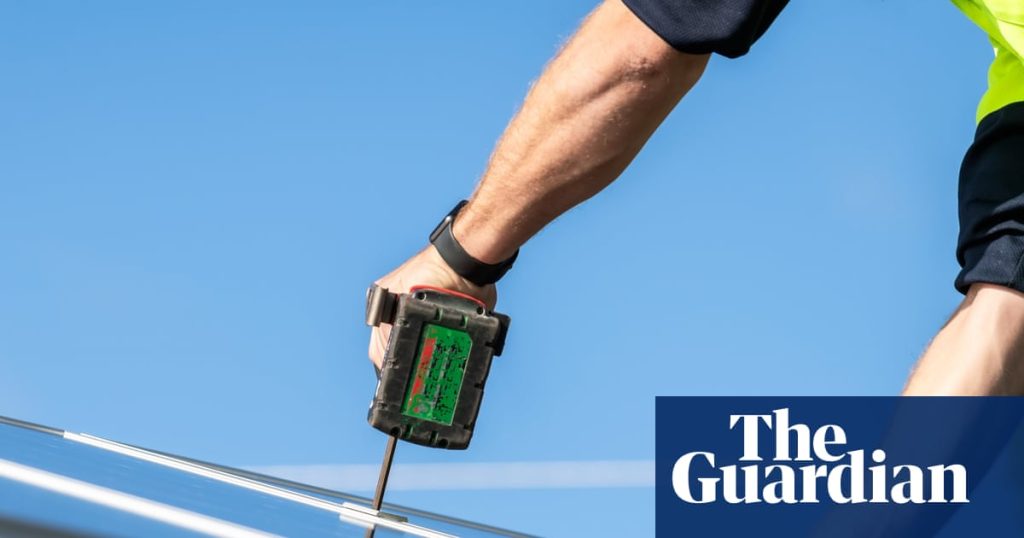Australian household energy bills will halve by 2050 as solar panels, batteries and electric cars and appliances become the norm, reducing pressure on the federal government over living costs and creating room for more climate action, a thinktank study suggests.
Modelling by the Grattan Institute finds that cutting greenhouse gas emissions from electricity generation in line with the goal of reaching net zero emissions by 2050 will cut average household energy costs from about $5,800 today to about $3,000.
The report says a fall of roughly this magnitude will happen under existing policies as households use less gas and petrol and more clean energy. The biggest savings are expected in gas-reliant Victoria, where the modelling suggests average annual spending on petrol, gas and electricity could fall from $6,036 to $2,767.
The report says emission cuts in the power sector are not happening fast enough and the mid-century net zero target will not be met without a policy requiring cuts in pollution from electricity.
The Grattan Institute has called on the government to consider expanding a policy applied to major industrial polluting sites – the safeguard mechanism – to include power plants. It says this would limit household energy savings compared with what would otherwise happen, but only marginally – by about 3%.
It says the safeguard mechanism is already a form of carbon pricing – language the Labor government has avoided since it lost a fraught political fight that culminated with the Coalition government under Tony Abbott abolishing a functioning carbon pricing scheme in 2014. The institute’s energy and climate change program director, Alison Reeve, said how people use energy has changed since then “and the politics of carbon pricing should change too”.
“For too long, federal governments of both political colours have avoided pricing carbon because they fear higher electricity prices,” Reeve said. “Our report shows that the source of that fear is becoming outdated.”
The Coalition introduced the safeguard mechanism and Labor revamped it in 2023. It requires about 200 industrial facilities that release more than 100,000 tonnes of carbon dioxide in Australia each year – including liquified natural gas plants, coalmines, smelters and factories – to reduce emission intensity by 4.9% each year until 2030.
The cuts can be made either on site or by buying carbon offsets. Companies that reduce emissions below a baseline level are also given “safeguard mechanism credits” that they can sell to polluters that do not meet their baseline.
Government data suggests the total direct pollution from facilities covered by the safeguard mechanism fell by nearly 2% in the first year after Labor’s revamp. But the scheme has been criticised for allowing unlimited use of offsets despite peer-reviewed studies suggesting they are failing to deliver what was promised.
A review of the safeguard mechanism is planned next year.
Reeve said the institute’s modelling assumed electricity companies would make direct emission cuts, and could not rely Australian carbon credits created through methods including improved nature cover.
Sign up to Clear Air Australia
Adam Morton brings you incisive analysis about the politics and impact of the climate crisis
Privacy Notice: Newsletters may contain information about charities, online ads, and content funded by outside parties. If you do not have an account, we will create a guest account for you on theguardian.com to send you this newsletter. You can complete full registration at any time. For more information about how we use your data see our Privacy Policy. We use Google reCaptcha to protect our website and the Google Privacy Policy and Terms of Service apply.
after newsletter promotion
She said a “pure” carbon tax or emissions trading scheme would be better than current policies, including the safeguard mechanism – a point also made by the longtime Labor climate and economics adviser Ross Garnaut – but Grattan had focused on what was politically achievable.
“Neither of those horses are in the race at the moment,” she said. “You can only bet on the horses that are in the race.”
Labor has faced criticism for delays in the rollout of solar and windfarms needed to meet its target of 82% of electricity coming from renewable sources by 2030.
Renewable energy in homes has boomed since the introduction of a battery subsidy in July. But investment in large-scale developments – particularly windfarms – has slowed, in part due to delays in planning approvals, construction of transmission links and supply chains.
The federal climate change and energy minister, Chris Bowen, said the government was focused on delivering existing policies, including an underwriting program for large solar, wind and battery developments (known as the capacity investment scheme), the $20bn “rewiring the nation” program and the battery subsidy. He said it was “looking at a range of post-2030 settings” but had no plans to include electricity in the safeguard mechanism.
Renewable energy provided 42% of electricity in the country’s main power grid over the past year.

